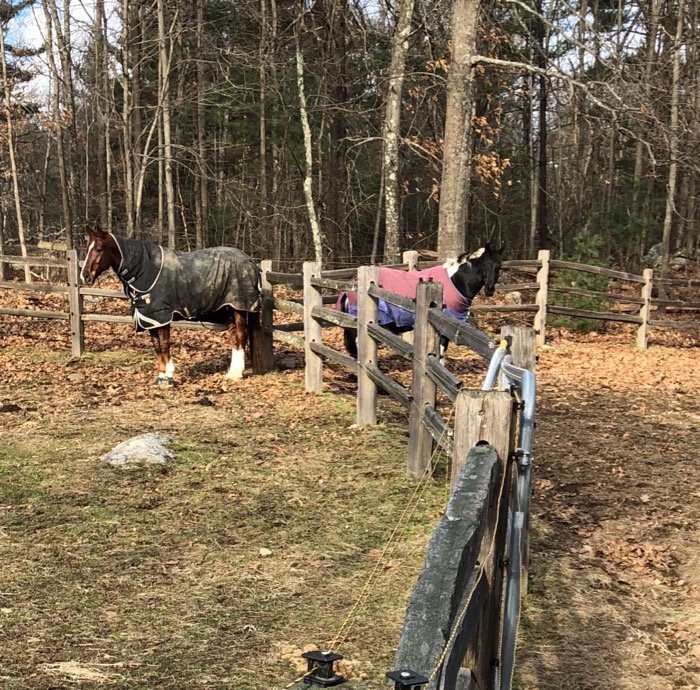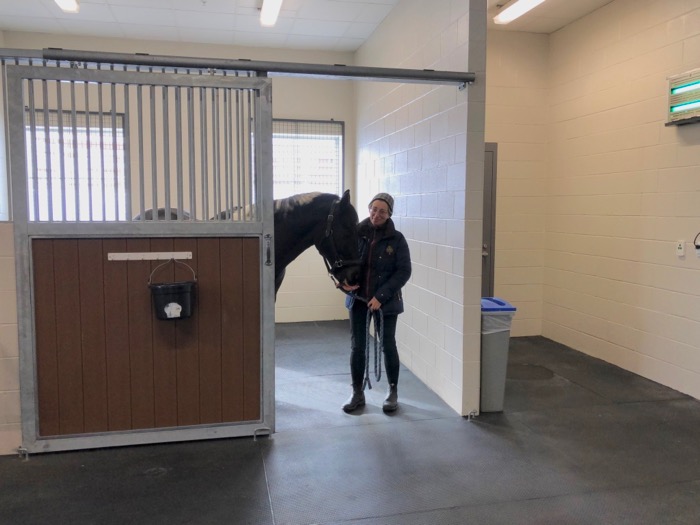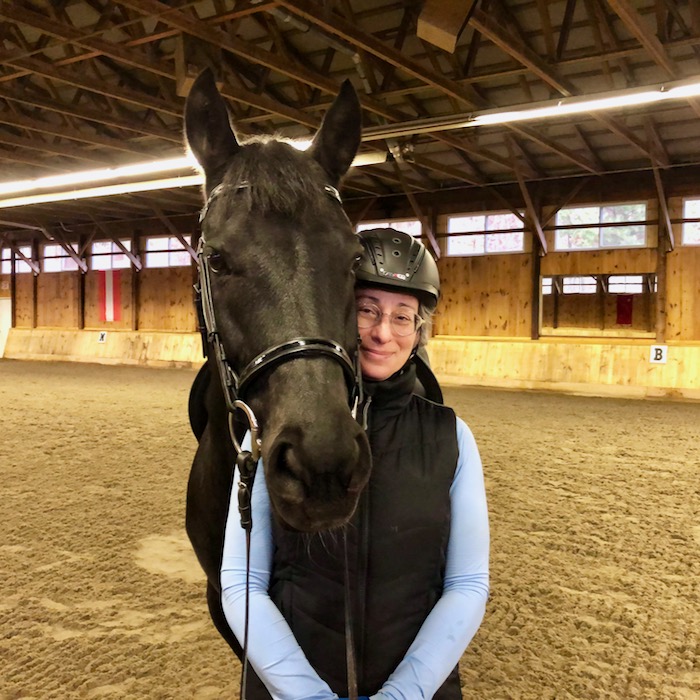My clients come to me with a mix of experience and training knowledge. Many of them are doing, or want to start, clicker training. Some have done a lot of research and have read books and watched videos. Some have found this training methodology on FaceBook. Almost all have heard that the first step is to teach a horse not to mug you for food, and to do that by clicking and treating for a head forward, or look away, position.
Did you play the telephone game as a child? One person whispers a phrase to the next, and then that person whispers it on down the line. You might start with “Susan likes sunflowers” and end up with “supper is at seven.” Learning about horse training is often like that. You miss the starting point.
Every one of the horses that I have worked with have had issues with food. Some are rescues and have been through periods of starvation. Some are horses that are boarded in places where they go through stretches without forage. Some are simply food hogs, and the presence of cookies gets them excited. (I’ve written more about why treats are problematic here.) You can teach these horses self-control around food, but it’s a challenge. I’ve seen people create food monsters out of horses that hadn’t been pushy before the training started. I’ve seen horses that ratchet up their energy level when their person arrives. These horse owners have come into the telephone game in the middle.
The real starting point is before you pick up the clicker or strap a treat pouch to your waist.
Observe your animals. They’ll tell you how to begin.
Here are Tonka and Deej. This is what they do together. Looks like not much. But this sort of calm, companionable inactivity is deeply satisfying to horses. I think that it’s more rewarding than cookies.

It’s easy for horses, but a challenge for humans! We arrive at the barn and want to interact, and we want the horse to be thrilled by our touching, grooming, and talking. We want things to happen. That’s one reason why we like to give treats. Horses look eager when presented with food. There’s nothing wrong with bringing a carrot when you say hello to your horse. I do it!
Just keep in mind that in the big scheme of things, horses want to do this:
At the end of this video Tonka lifted his head to suss out my camera (I was on the outside of the paddock, holding my phone through the fence to film.) When I told him it was me, Tonka relaxed and put his head down. That was a moment of trust and calm! That’s what we’re training for, aren’t we?
Horses in a natural environment have access to all of the food that they desire, right at their feet. They communally and companionable graze. But domestic horses are often in situations where food is limited, and they have to protect their stash from others. This leads to anxiety and resource guarding. Before you can train with food, check if your horse is relaxed eating in your presence. If not, have a seat on the ground.

Once your horse is calm when you’re near him and he’s eating, keep doing this. Do it without demands of interaction, without talking, or touching. Simply hang out. This could become the happy place for both of you.
Isn’t this the best perspective? (For safety, though, always keep an eye on where the hoofs are, and stand, or sit on a chair if there’s a chance of being barged into!)
As you saw in that photo of Deej and Tonka, horses hang out together, even when not eating. Do that with your horse, too. I actually train my students how do “nothing.” These two had to trust in the stillness. It’s becoming innately reinforcing for both of them.

You can rather quickly convey to your horse that you’re there just to hang out and not put demands on them. This OTTB and her owner are new to each other. I was called in because when the mare saw her person walking towards her, she’d warily walk away. After twenty minutes in our first session, the mare was not only approachable, but relaxed, and seemed to appreciate the attention.

It’s at this point that you’re able to continue with the training, and use food rewards if you want to. In this case, we were able to bring the halter over without the mare taking off! We also started teaching a “head up” cue, with the behavior reinforced by some hay pellets.
You want this peaceful “nothing” time to become the default of how you relate to each other. It’s why Tonka was so chill at the vet hospital.

It’s a factor in why he’s not stressed under saddle. Horse people call the expression that you see in this photo a “soft eye.”

You get that by letting go of your own agenda, and meeting your horse at their place of contentment. That is where you will hear the first phrase in this telephone game of training. From that start, you can do anything.
If you liked this post, consider following this blog. Sign up at the right on this page, and you’ll get an email whenever I post. As always, I appreciate it when you share my work. Thanks!


When I was in elementary school, I and several of my school friends had horses and lived next to Bridle Trails State Park near Seattle. We’d agree to meet after class, with our horses, at some place in the Park and go riding together. One of my friends, Corrine, had a tall Palomino, and she was only able to climb aboard because her horse would put his head down, she’d straddle his neck and she’d slide down his neck onto his back as he raised his head. My mare would rear in a moderate way with just a little tug on the reins in our impression of the Lone Ranger and Silver. None of these horses were expensive, all of the horses were kept at home, and all of the horses took care of their kids.
As an adult I didn’t recognize the importance of hanging out or unstructured time. When I started riding again in middle age, I focused on clinics, groundwork exercises and riding techniques that left my horses and me stressed.
Thanks for this reminder to spend time hanging out with our horses!
Thank you for this comment! What a wonderful childhood. It’s terrific that you have a horse in your adult life. I hope you can channel some of your inner child back into your time at the barn 🙂
I love your work. When I get too busy, monkey brained, you always help bring me back to what is important, in the kindest, quietest way. thank you.
I love the craft of writing (almost) as much as being with horses. This post took me 4 hours to write – so hearing that it is appreciated is welcome affirmation!
Just to let you know once again, I appreciate your posts. This one was another reminder for me. I used to hang out with my horses more than i do now, except now that I read this I’m going to start hanging out with them more.
Good! I’m going to take my own advice and hang out with my goats more 🙂